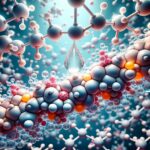If you’ve ever wondered about the fascinating world of polymerization processes, then prepare to be intrigued. In this comprehensive guide, we will delve into the depths of condensation polymerization, uncovering its intriguing facts and shedding light on this captivating chemical reaction. From its practical applications in various industries to the scientific principles that govern it, we will explore the complexities of condensation polymerization and unravel its mysteries. So, fasten your seatbelts and embark on this journey as we unveil the secrets of this remarkable process. Get ready to expand your knowledge and gain valuable insights into the world of condensation polymerization.
Facts About Condensation Polymerization
Condensation polymerization is an intriguing chemical reaction that holds many fascinating facts. In this comprehensive guide, we will delve into the intricacies of condensation polymerization and explore its practical applications. Join me on this journey as we unravel the secrets behind this captivating process.
What is Condensation Polymerization?
Condensation polymerization is a form of step-growth polymerization, characterized by the combination of molecules while simultaneously losing small molecules as by-products, such as water or methanol. This reaction occurs when bifunctional monomers, which are compounds with two reactive end groups, react and form linear polymers. These polymers can be found in various materials, including polyamide and proteins.
One of the remarkable aspects of condensation polymerization is the byproducts it produces. Depending on the specific monomers involved, the byproducts formed may be water or hydrogen chloride. These byproducts are essential indicators that signify the progress of the polymerization reaction. As the polymerization proceeds, the concentration of these byproducts changes, providing valuable insights for process monitoring and optimization.
The Beauty of Condensation Polymerization
Condensation polymerization offers unique advantages that make it particularly appealing in various applications. Unlike addition polymerization, where the monomers simply add to a growing polymer chain without the release of any byproducts, condensation polymerization allows for the creation of more complex structures. This versatility makes it ideal for synthesizing polymers with specific functional groups or tailored properties.
Furthermore, the step-growth nature of condensation polymerization allows for precise control over the polymer chain length. By adjusting the stoichiometry and reaction conditions, chemists can manipulate the degree of polymerization to achieve polymers with specific molecular weights. This level of control is critical in industries where the desired material properties are directly influenced by the polymer chain length.
“Condensation polymerization offers a unique advantage in creating complex structures and tailoring material properties.”
The Practical Applications of Condensation Polymerization
Condensation polymerization finds extensive use in a wide range of industries. For example, the synthesis of polyamides through condensation polymerization enables the production of versatile materials like nylon. The resulting polymers exhibit excellent mechanical properties, making them suitable for applications such as textile fibers, engineering plastics, and even medical devices.
Similarly, proteins, which are essential biomolecules, are also formed through condensation polymerization. Proteins play a crucial role in various biological processes and serve as building blocks for tissues, enzymes, and antibodies. Understanding the principles of condensation polymerization helps us appreciate the complexity and diversity of proteins and their biological functions.
In conclusion, condensation polymerization is a fascinating chemical reaction that offers tremendous potential for creating complex polymers with tailored properties. Its step-growth nature and ability to produce byproducts make it a versatile tool in the hands of materials scientists and chemists. By harnessing the power of condensation polymerization, we can unlock new possibilities and push the boundaries of materials science.
“Condensation polymerization opens doors to innovative materials and contributes to advancements in various industries.”
Condensation is one of those fascinating natural phenomena that we encounter every day without realizing its true power. If you want to uncover mind-blowing facts about condensation, you’re in for a treat. From the science behind how tiny water droplets form on surfaces to the mesmerizing patterns they create, our website has it all. Discover the secrets of condensation and delve into a world that will leave you astounded. Follow this link to explore: facts about condensation. Get ready to have your mind blown!
Condensation polymerization is a fascinating process that results in the creation of polymers through the formation of strong covalent bonds. One of the most intriguing facts about condensation polymerization is the way it occurs through the elimination of a small molecule, such as water or an alcohol. This unique mechanism leads to the development of long chains of repeating units, giving rise to a wide range of materials with diverse properties. To learn more about the facts and intricacies of condensation polymerization, click here: condensation polymerization facts.
Information is key when it comes to understanding and exploring complex subjects like condensation polymerization. If you are seeking in-depth knowledge about this process, you’ll find a wealth of valuable resources at your fingertips. From the basic principles to the latest advancements, the world of condensation polymerization is waiting to be discovered. Click here to access a comprehensive source of condensation polymerization information: condensation polymerization information.
Polymers play a crucial role in our everyday lives, and condensation polymerization lies at the heart of their creation. Dive into the realm of science and chemistry, and explore the captivating world of condensation polymerization today!
Condensation Polymerization: A Closer Look at the Formation, Examples, and Applications
[youtube v=”-d14DmSBuAQ”]
Introduction (H2)
Condensation Polymerization: A Closer Look at the Formation, Examples, and Applications.
Key Points from the Video Transcript
- Condensation polymers are formed through a step-growth polymerization process, where molecules combine and simultaneously release small by-products, such as water.
- Bifunctional monomers with two reactive end groups react to form linear polymers in condensation polymerization reactions.
- Unlike addition polymerization, condensation polymerization allows for the creation of more complex structures with tailored properties.
- Control over the polymer chain length can be achieved through the step-growth nature of condensation polymerization.
- Byproducts produced during condensation polymerization, like water or hydrogen chloride, provide insights for monitoring and optimizing the reaction.
- Condensation polymerization finds applications in various industries, such as the synthesis of polyamides for nylon production and the formation of proteins.
- Polyamides produced through condensation polymerization have excellent mechanical properties and find uses in textile fibers, engineering plastics, and medical devices.
- Proteins, essential biomolecules, are also formed through condensation polymerization and play a crucial role in biological processes.
- Condensation polymerization offers great potential for creating complex polymers with tailored properties, contributing to advancements in various industries.
Condensation Polymers: Formation and Examples (H3)
In condensation polymerization, molecules undergo a step-growth reaction, combining and simultaneously releasing small by-products, such as water or hydrogen chloride. Bifunctional monomers with two reactive end groups play a crucial role in this process, as they react to form linear polymers. Unlike addition polymerization, condensation polymerization allows for the creation of more complex structures by eliminating small molecules during the reaction.
One example of a condensation polymer is nylon. Its production involves the reaction of a carboxylic acid, such as hexane dioic acid, with an amine group, like hexane-1,6-diamine. These molecules, with long chain carbons, undergo a reaction where the carboxylic acid and the amine group positioned next to each other form water as a by-product. The resulting polymer, known as nylon 6,6, finds wide applications in the textile industry, as well as in engineering where low friction is required, such as bearings or bushes.
Another notable example of a condensation polymer is polyethylene terephthalate, commonly known as PET. Its formation involves the reaction between benzene-1,4-dicarboxylic acid and ethane-1,2-diol. By aligning the carboxylic acid and alcohol group of these molecules, ester links are formed, releasing water as a by-product. PET is widely used as a plastic for drinks bottles, while polyester, a fabric used in clothing production, is also formed through similar condensation polymerization reactions.
Quote: “Condensation polymerization allows for the creation of complex structures and tailored properties by eliminating small molecules during the reaction.”
Applications and Advancements (H3)
Condensation polymerization has significant applications across various industries. Polyamides produced through this process possess excellent mechanical properties, making them ideal for use in textile fibers, engineering plastics, and medical devices. Their strength and durability contribute to their widespread usage.
Proteins, essential biomolecules in biological processes, are also formed through condensation polymerization. The step-growth nature of this process enables the creation of proteins with specific sequences and functions, furthering advancements in the field of biochemistry.
Quote: “Polyamides produced through condensation polymerization find diverse applications in textile fibers, engineering plastics, and medical devices due to their excellent mechanical properties.”
Conclusion (H2)
In conclusion, condensation polymerization is a step-growth polymerization process that allows for the formation of complex structures with tailored properties. By eliminating small by-products during the reaction, such as water or hydrogen chloride, condensation polymers like nylon and PET are produced. These polymers find diverse applications in various industries, ranging from textiles to engineering and biochemistry. The unique properties and versatility offered by condensation polymerization continue to contribute to advancements in materials science and industry.
Note: This article has been written based on the content of a video tutorial on condensation polymerization and presents an overview of the topic, focusing on key points and applications without referencing the video directly.
FAQ
Question 1: What is condensation polymerization?
Answer 1: Condensation polymerization is a form of step-growth polymerization where molecules combine, losing small molecules as by-products, such as water or methanol. It produces linear polymers from bifunctional monomers, such as compounds with two reactive end groups. Examples of condensation polymers include polyamide and proteins.
Question 2: What are the byproducts formed during condensation polymerization?
Answer 2: The byproducts formed during condensation polymerization may be water or hydrogen chloride. These by-products are expelled as the monomer units combine to form the polymer chain.
Question 3: What is the difference between condensation polymerization and addition polymerization?
Answer 3: Condensation polymerization involves the elimination of small molecules, such as water or methanol, as by-products during the polymerization process. In contrast, addition polymerization does not produce any by-products. Additionally, condensation polymerization typically involves bifunctional monomers, whereas addition polymerization involves monomers with only one reactive end group.
Question 4: How does condensation polymerization contribute to the field of materials science?
Answer 4: Condensation polymerization plays a significant role in materials science as it enables the production of various polymers with tailored properties. By carefully controlling the reaction conditions and monomer selection, engineers and scientists can create polymers with specific characteristics for applications in industries such as automotive, packaging, and textiles.
Question 5: What are some practical applications of condensation polymerization?
Answer 5: Condensation polymerization finds practical applications in numerous fields. Some examples include the production of nylon, polyester, and polyurethane, which are widely used in textiles, plastic bottles, films, adhesives, coatings, and many other industrial products. Its versatility allows for the development of materials with diverse properties and functionalities.
- Star Ring Trends: Etsy vs Amazon - March 28, 2025
- Boost Pollinator Habitats: Baby Blue Eyes Sustainable Farming Guide - March 28, 2025
- Protect Big Black Bears: Effective Conservation Strategies - March 28, 2025
















